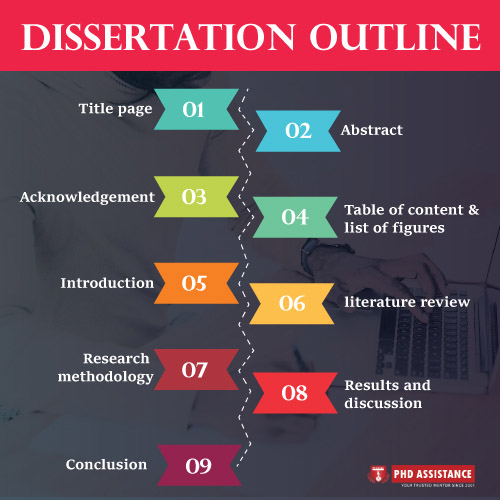How To Structure Your Phd Computer Science Uk Dissertation?
In-Brief
- A dissertation is the final stage of the Ph.D. program, and it allows you to demonstrate that you have acquired the skills and expertise required to plan and execute a research project.
- It should show that you are capable of finding a suitable research area or area.
- Dissertations need to demonstrate knowledge and understanding beyond the Ph.D. level and reach a level of scope and depth beyond that taught in class.

Introduction
The PhD Dissertation is the final stage of the PhD Programme, and it allows you to demonstrate that you have acquired the skills and expertise required to plan and execute a research project. It should show that you are capable of finding a suitable research area or areas: establishing research goals; locating, organising, and critically analysing applicable secondary data and authoritative literature, deciding on a Research Methodology that is appropriate; analysing the primary data and writing on relevant field literature; drawing conclusions; and, if possible, making relevant recommendations and indicating areas for further study.
The Dissertation in Outline:
2.1. Aims of the Dissertation
The dissertation’s goals are to:
- bring theories and principles learned on the programme into practice
- provide an opportunity to research of specific subject in depth
- demonstrate proof of independent investigation
- combine applicable theories and propose alternatives
- enable contact with practitioners
After completion of the dissertation, students should be able to:
- describe, plan, and present a piece of academically rigorous research;
- demonstrate vital and systematic knowledge, as well as a deeper understanding of their chosen subject area
- appreciate the practical consequences and constraints of the specialized subject;
- Understand the process and decisions to be made in managing a project within strict deadlines
Dissertation Styles
Dissertations need to demonstrate knowledge and understanding beyond the PhD level and reach a level of scope and depth beyond that taught in class. To ensure that the dissertation’s specific goals are met, all dissertations must be presented in an excellent academic style and format. It is critical that the dissertation’s goals and objectives are stated clearly and that they are attainable within the dissertation system’s confines. Academic style encompasses more than just speech clarity, grammar, and attribution and referencing. Nonetheless, it refers to a well-structured approach to the reasoning and validation of evidence, hypotheses, and viewpoints offered in order to construct a precise statement.
You will not usually be required to undertake a viva voce examination of your dissertation. The dissertation is assessed on the basis of the content of your submitted document alone. The type of research dissertation can differ depending on the subjects taught at the School. Your Program Director will provide you with detailed instructions.
Key Milestones
Outline of main stages in the Dissertation Proposal
- Intercultural Translation and Interpreting Studies and Translation and Interpreting Studies in the International Context
- Dissertation Presentation
- Dissertation Proposal Hand-in and Final Approval by Academic Supervisor
- Examination Progression Board confirms permission to conduct dissertation
- Dissertation Presentation
- Dissertation Proposal Hand-in and Final Approval by Academic Supervisor
Responsibilities of the Student
- To keep in touch with the academic supervisor on a daily basis. It is the student’s duty to keep their supervisor up to date on their progress and to lead the dissertation’s production. Difficulties should be shared as soon as they arise. Knowledge from the past is not permissible.
- To write the dissertation in a simple and professional manner, using acceptable academic terminology and citation and referencing conventions. It is not the supervisor’s duty to ensure that this requirement is met.
- With the support of the supervisor, write the dissertation. You must write your own dissertation and research paper. The dissertation should show your knowledge of the subject and research skills, not those of your supervisor.
- Where a company project is being conducted, to attend as required on a regular basis, to maintain regular contact with the company sponsor, and to give a final presentation to the management team.
- Any absence during the time allotted for working on the dissertation should be reported to the Programme Director and academic supervisor.
Writing dissertation
To complete his or her doctoral degree, every Computer Science Doctoral Student must write a good PhD dissertation. As a result, the PhD student should recognize the value of writing a strong dissertation and doing thorough studies for his or her doctoral degree. To write a good PhD Computer Science Dissertation, you’ll need a solid strategy, broad reasoning capacity, good thesis subject range, adequate direction, good decision-making abilities, dedication, and hard work, among other things. To tell the truth, there is no set model or programmed for PhD students. As a result, the student should carefully analyze and discuss his or her own abilities. Writing a successful PhD computer science dissertation needs assistance.
For a doctoral student to write a good dissertation, he/she should meticulously develop a strong structure for his/her dissertation. To develop a strong structure, the foundation of the dissertation should be strong and stable in the first place. So, the scholar should wisely select a good dissertation topic to establish a strong foundation for his/her research.

TITLE PAGE
This first page of the dissertation is Title page, and it should include the title of the research work, the PhD student’s name with registration number, supervisor’s name, course and department names, the college logo, and the submission date. Make sure the title is short, catchy, and easy to find on the internet. The aim, purpose, and research work undertaken should all be elucidated in an ideal dissertation title. A decent dissertation title should be no more than 7 to 9 words in length.
ABSTRACT
An optimal abstract should be no more than 200 to 250 words long and outline the main concept of the dissertation. According to the quotation, “The face is the index of the mind,” this part is the dissertation’s index, so the scholar can draught it meticulously and with great care. Despite the fact that the abstract is brief, this is the first (and sometimes only) segment that people can read. As a consequence, it is important to get it right. Make sure your abstract covers the following points [10]:
- Describes the aim, objective and main idea of the research work.
- Defines the problem statement and solution for it.
- Outlines the methodology, problem -solving technique.
- Summarizes the results (preferably in numbers or values).
- Concludes with a proper conclusion.
Students may also use a skilled computer science dissertation service provider’s computer science research paper abstract writing service to draught a successful abstract.
ACKNOWLEDGEMENT
This segment is solely for expressing your appreciation to the institution, department, higher officials, advisors, other faculties, colleagues, parents, and those who assisted you in the dissertation writing process.
TABLE OF CONTENT & LIST OF FIGURES
For the sake of the reader’s convenience, the scholar should list all of the chapters and subheadings in the table of contents by page number. Additionally, the list of percentages, charts, and abbreviations is tabulated for the readers’ convenience.
INTRODUCTION
This section should offer the readers a quick overview of the Research Subject, the problem statement to be answered, and the reason for conducting this research. In the introduction, the scholar should make sure to note the following:
- Decide your research topic and previous works on the subject.
- Restrict the subject and define the scope of the study.
- Make a list of your research questions and the aim of this study [11]
LITERATURE REVIEW
Literature Review is one of the major important parts of the dissertation because it requires the scholar to have a thorough understanding of previous works on the subject. The scholar is supposed to do the following in this section;
- Gather all appropriate sources for his or her research subject.
- Analyze all of the references you’ve gathered thoroughly.
- Compare and contrast each research project’s similarities, methods, and problem-solving strategy.
After completing the Literature Review process, the scholar will be able to easily recognise research holes and other hypotheses in the chosen subject. Following that, the scholar should formulate new theory and methods, and finally, the scholar should conclude this section by proposing a theoretical solution to the unresolved issue.
2.8 RESEARCH METHODOLOGY
The methodology portion of a Professional Computer Science Dissertation should explain the problem solution, methods used, and experiments carried out during the research process. Data collection and analysis is a crucial part of any research project. As a result, check to see if the student is extracting and analysing data correctly. Multiple data collection and data analysis computer science dissertations related to the current research should be consulted. In addition, the following items should be included in this section:
- The process used to approach the problem and the type of research performed.
- Data Collection and Analysis processes
- The apparatus and materials are used in the experiment, as well as the lab facility.
- Problems faced during the testing process.
- Validation of the research methods used in the process [12].
RESULTS AND DISCUSSION
The results of the experiments should be discussed in this portion of the dissertation, which is the most critical element. The scholar must ensure that the real findings are not manipulated or exaggerated. In addition, graphs, tables, maps, and figures should be included for illustrating purposes. Only the necessary findings should be presented by the student. Avoid showing charts or statistics that repeat details that has already been clarified.
2.10 CONCLUSION, REFERENCE, APPENDICES
In the conclusion part, the student wraps up the project by quickly summarising the entire study process. The merits, benefits, and scope of the current work are all addressed in the conclusion section. It’s also crucial to mention the research’s future plans. This segment should explain the current work’s achievements conclusively.
It is required that you cite all of the references you used to write your dissertation. It can be called intellectual theft or plagiarism if the scholar fails to acknowledge the work of others. As a consequence for the reference, it is highly recommended that you bookmark or save the sources as you read them.
The dissertation would not be enough to show any of the empirical findings in their entirety. Usually, material that does not explicitly relate to addressing the study questions is removed from the main body of the dissertation and thus inserted in this segment.
REFERENCES
- Hair Jr, Joseph F., and Marko Sarstedt. “Data, measurement, and causal inferences in machine learning: opportunities and challenges for marketing.” Journal of Marketing Theory and Practice (2021): 1-13.
- Chantry, Matthew, Hannah Christensen, Peter Dueben, and Tim Palmer. “Opportunities and challenges for machine learning in weather and climate modelling: hard, medium and soft AI.” (2021): 20200083.
- Namasudra, Suyel. “Data access control in the cloud computing environment for bioinformatics.” International Journal of Applied Research in Bioinformatics (IJARB) 11, no. 1 (2021): 40-50.
- Shahidinejad, Ali, Mostafa Ghobaei-Arani, and Mohammad Masdari. “Resource provisioning using workload clustering in cloud computing environment: a hybrid approach.” Cluster Computing 24, no. 1 (2021): 319-342.
- Anuradha, M., T. Jayasankar, N. B. Prakash, Mohamed Yacin Sikkandar, G. R. Hemalakshmi, C. Bharatiraja, and A. Sagai Francis Britto. “IoT enabled cancer prediction system to enhance the authentication and security using cloud computing.” Microprocessors and Microsystems 80 (2021): 103301.
- Bhattacharya, Sweta, Praveen Kumar Reddy Maddikunta, Quoc-Viet Pham, Thippa Reddy Gadekallu, Chiranji Lal Chowdhary, Mamoun Alazab, and Md Jalil Piran. “Deep learning and medical image processing for coronavirus (COVID-19) pandemic: A survey.” Sustainable cities and society 65 (2021): 102589.
- Agrawal, Prateek, Deepak Chaudhary, Vishu Madaan, Anatoliy Zabrovskiy, Radu Prodan, Dragi Kimovski, and Christian Timmerer. “Automated bank cheque verification using image processing and deep learning methods.” Multimedia Tools and Applications 80, no. 4 (2021): 5319-5350.
- Logler, Nick, Naomi Jacobs, Anna Melnyk, Adam Poulsen, Molly Balcom Raleigh, Till Winkler, and Alan Borning. “PhD Student Perspectives on Value Sensitive Design.” ETHICOMP 2020 (2020): 207.
- Lund, Brady. “The structure of information behavior dissertations 2009–2018: Theories, methods, populations, disciplines.” Journal of Librarianship and Information Science (2020): 0961000620935499.
- Morales, Oscar Alberto, Bexi Perdomo, Daniel Cassany, Rosa María Tovar, and Élix Izarra. “Linguistic structures and functions of thesis and dissertation titles in Dentistry.” Lebende Sprachen 65, no. 1 (2020): 49-73.
- Hanson, Janet, William Loose, and Ursula Reveles. “A qualitative case study of all-but-dissertation students at risk for dissertation noncompletion: A new model for supporting candidates to doctoral completion.” Journal of College Student Retention: Research, Theory & Practice (2020): 1521025120910714.
- McKendrick, M., S. Yang, and G. A. McLeod. “The use of artificial intelligence and robotics in regional anaesthesia.” Anaesthesia76 (2021): 171-181.
- Oniani, Salome, Gonçalo Marques, Sophio Barnovi, Ivan Miguel Pires, and Akash Kumar Bhoi. “Artificial Intelligence for Internet of Things and Enhanced Medical Systems.” In Bio-inspired Neurocomputing, pp. 43-59. Springer, Singapore, 2021.
- Ali, Mohammed Banu. “Multi-Perspectives of Cloud Computing Service Adoption Quality and Risks in Higher Education.” In Handbook of Research on Modern Educational Technologies, Applications, and Management, pp. 1-19. IGI Global, 2021.
 Previous Post
Previous Post Next Post
Next Post
